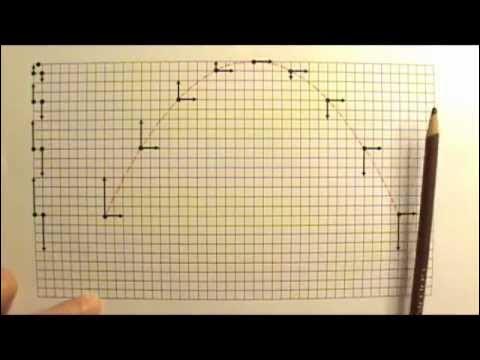Two Dimensional Motion Problems - Physics
Summary
TLDRThis video tutorial explores a two-dimensional motion problem involving a ball rolling off a 500-meter cliff at 5 m/s. It guides viewers through calculating the time to hit the ground, the horizontal range, and the final speed and velocity before impact using kinematic equations. The video also discusses projectile motion, free fall, and provides formulas for solving similar problems, encouraging viewers to check out additional resources for a deeper understanding.
Takeaways
- 📚 The video discusses a two-dimensional motion problem involving a ball rolling off a cliff.
- 🏞 The cliff is 500 meters high and the ball rolls off horizontally at 5 meters per second.
- 🕒 The time it takes for the ball to hit the ground is calculated using the kinematic equation for vertical motion.
- 📉 The initial vertical velocity (v y initial) is zero because the ball starts with only horizontal motion.
- 🌐 The vertical acceleration due to gravity is -9.8 m/s², which is used in the kinematic equation.
- 🔢 The calculated time for the ball to hit the ground is 10.1 seconds.
- 📏 The horizontal range or displacement of the projectile is found by multiplying the horizontal velocity (5 m/s) by the time of flight (10.1 s), resulting in 50.5 meters.
- 🚀 The final vertical velocity is calculated by adding the acceleration due to gravity over time, resulting in -98.98 m/s.
- 📐 The final speed of the ball before impact is found using the Pythagorean theorem, which yields 99.1 m/s.
- 🧭 To find the direction of the final velocity, the angle is calculated using the arctan function, giving an angle of 272.9 degrees from the positive x-axis.
- 📈 The video provides guidance on where to find additional resources, such as other videos on kinematics, projectile motion, and free fall physics.
Q & A
What type of motion is being discussed in the video?
-The video discusses two-dimensional motion, specifically horizontal and vertical components of projectile motion.
What is the initial condition of the ball's motion in the video?
-The ball rolls horizontally off a 500-meter cliff at a speed of 5 meters per second.
What is the formula used to calculate the time it takes for the ball to hit the ground?
-The formula used is the kinematic equation for vertical motion: y_final = y_initial + v_y_initial * t + (1/2) * a * t^2.
What is the initial vertical velocity of the ball?
-The initial vertical velocity of the ball is 0 meters per second, as it starts with only a horizontal component of velocity.
What is the acceleration acting on the ball in the vertical direction?
-The acceleration acting on the ball in the vertical direction is the acceleration due to gravity, which is -9.8 m/s².
How long does it take for the ball to hit the ground?
-It takes 10.1 seconds for the ball to hit the ground.
What is the range of the projectile in this problem?
-The range, or horizontal distance the ball travels before hitting the ground, is 50.5 meters.
What is the final speed of the ball just before it hits the ground?
-The final speed of the ball just before it hits the ground is 99.1 meters per second.
How do you calculate the final velocity of the ball?
-The final velocity is calculated by combining the horizontal and vertical components of velocity using the Pythagorean theorem and considering the direction of the velocity vector.
What is the direction of the ball's final velocity just before it hits the ground?
-The direction of the ball's final velocity is 272.9 degrees counterclockwise from the positive x-axis.
What additional resources are recommended for understanding two-dimensional motion problems?
-The video recommends watching additional videos on kinematics, projectile motion, and free fall physics by Organic Chemistry Tutor on YouTube.
Outlines

Esta sección está disponible solo para usuarios con suscripción. Por favor, mejora tu plan para acceder a esta parte.
Mejorar ahoraMindmap

Esta sección está disponible solo para usuarios con suscripción. Por favor, mejora tu plan para acceder a esta parte.
Mejorar ahoraKeywords

Esta sección está disponible solo para usuarios con suscripción. Por favor, mejora tu plan para acceder a esta parte.
Mejorar ahoraHighlights

Esta sección está disponible solo para usuarios con suscripción. Por favor, mejora tu plan para acceder a esta parte.
Mejorar ahoraTranscripts

Esta sección está disponible solo para usuarios con suscripción. Por favor, mejora tu plan para acceder a esta parte.
Mejorar ahoraVer Más Videos Relacionados

A student stands at the edge of a cliff and throws a stone horizontally

Ecuaciones paramétricas 1

AP Physics 1: Kinematics 17: Projectile Part 2: Shot at an Angle (Symmetric)

12-88 | Engineering Dynamics Hibbeler 14th Edition | Engineers Academy

Gerak Parabola • Part 2: Contoh Soal Gerak Parabola Dimulai dari Tanah

Two Dimensional Motion (4 of 4) Horizontal Projection, Worked Example
5.0 / 5 (0 votes)
